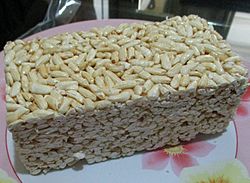Jipang (food) facts for kids

Rice jipang
|
|
| Alternative names | Bipang, berondong beras |
|---|---|
| Course | Snack |
| Place of origin | Indonesia, China, Taiwan |
| Main ingredients | Rice, glutinous rice, sugar |
Jipang is a yummy traditional snack. It is made from rice or a special type of rice called glutinous rice. You might also hear it called bipang or berondong beras. It's a popular sweet treat in many places!
Contents
Where Jipang Comes From
The name bipang comes from a Chinese language called Hokkien. In Hokkien, bí-phang means "fragrant rice." This name fits because jipang is a sweet and tasty snack.
Jipang is one of the oldest and most loved traditional snacks from China. Long ago, Chinese people moved to Indonesia. They brought jipang with them and started selling it there. Some of these old jipang businesses are still open today! For example, Toko Bipang Jangkar in Pasuruan, East Java, has been making jipang since 1940. That's a very long time!
How Jipang is Made
The way jipang is made can be different. It depends on where you are and even which family is making it. Large factories use big machines. But people also make jipang by hand in traditional ways.
The main things needed to make jipang are rice and sugar. For the best jipang, people often use rice that has been stored for a few days.
Interestingly, jipang sells more during the monsoon season. This is the rainy season. Sales go down in the summer. This might be because people avoid snacks that make them thirsty when it's hot.
Making Jipang in Factories
In big factories, special machines are used to make jipang. First, the rice is roasted. This happens over a very hot gas stove or gas burner. Then, the rice pops open.
Next, the popped rice is mixed with sweet caramelized sugar. This gives jipang its classic sweet taste. Before the mixture gets hard, it is spread out on a table. Workers then cut it into pieces. Finally, the jipang pieces are ready to be packaged.
Making Jipang by Hand
In a place called Lahat in South Sumatra, jipang is very popular during the lebaran holiday. The jipang made here is different from factory-made jipang. It is made by hand using glutinous rice.
First, the glutinous rice is washed. Then, it is soaked in water. After that, it is covered with brown sugar. The rice is then dried under the sun. Finally, it is fried until it becomes crispy and delicious.
See also
 In Spanish: Jipang para niños
In Spanish: Jipang para niños

